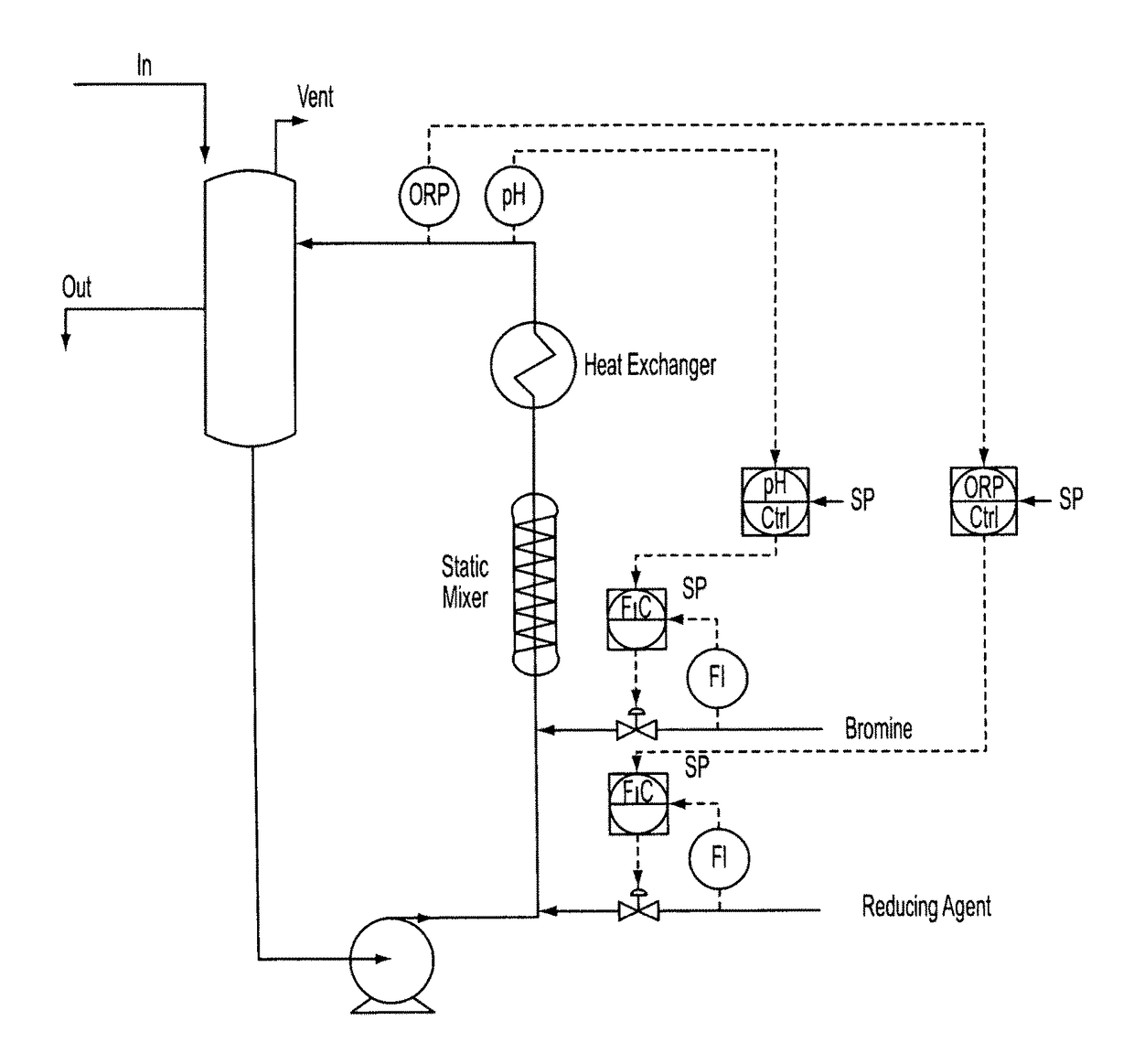Method for making bromides
a bromide and bromide technology, applied in the field of bromide making, to achieve the effects of reducing waste, high purity, and fast and more efficient production
- Summary
- Abstract
- Description
- Claims
- Application Information
AI Technical Summary
Benefits of technology
Problems solved by technology
Method used
Image
Examples
example 1
cess for CaBr2
[0064]Stage 1—To 870 grams, 11.4 moles, of hydrated lime as a 37.6% aqueous slurry in a stirred reaction vessel is added 408 grams, 6.8 moles, of ammonia as a 28.5% aqueous solution. The reaction vessel is immersed a water bath and 1,635 grams, 10.23 moles, of bromine is added below the surface of the reaction mixture at a rate to keep the reaction temperature below 70° C.
[0065]Stage 2—About 85% of the reaction mixture from stage 1 (the remainder is held back to use in pH adjustment of the final reaction product) is transferred at room temperature to a reaction vessel equipped with pH probe and ORP probe. The reaction mixture is stirred and HBr is added to lower pH to 0.60. The amount of Br2 needed to complete conversion of lime to CaBr2 is added below the reaction surface through a feed under pH cascade control (set at ˜0.60), and a solution of hydrazine is added manually hydrazine to maintain an ORP value below 600 mV.
[0066]Product adjustment stage—Material held bac...
example 2
s Process for CaBr2—Loop Plus Agitated Reactor Setup
[0067]Stage 1—Into a loop reactor equipped with inline static mixer and heat exchanger with cooling tower water on the shell-side is fed lime slurry, 10.1 kg / h, gaseous ammonia, 1.35 kg / h, and bromine, 19.05 kg / h. The ammonia feed is teed into the lime slurry feed which creates a mixture of lime and aqueous ammonia prior to exposure of the lime to bromine. The reaction is heated by the exotherm from Br2 / NH3 reaction and is allowed to exceed the by of Br2 due to the increased pressure created at the discharge of the recirculation pump and at the bromine addition point. Liberated nitrogen is vented to a sodium hydroxide process scrubber after passing through the gas-liquid separator.
[0068]ORP is monitored online to ensure the feed ratios are stoichiometric. Feed of the reaction mixture to the Stage 2 reactor is controlled by gravity overflow from Stage 1 gas-liquid separator.
[0069]Stage 2—The reaction mixture from stage 1 is stirred ...
example 3
s Process for CaBr2—Dual Loop Reactor Setup
[0071]Stage 1—Run following the procedure of Example 2.
[0072]Stage 2—The feed from stage 1 is introduced into a loop reactor equipped with inline static mixer, heat exchanger and the pH and ORP cascade control systems shown schematically in FIG. 1. Hydrazine (35% solution) is charged via cascade control to maintain a +640 mV ORP; bromine is charged via cascade control to maintain a pH of −1.8. Initial feed rates anticipate 1.29 kg / h of lime (from the stage 1 reaction product), 2.41 kg / h bromine and 0.24 kg / h hydrazine. Nitrogen is liberated and is vented off to the sodium hydroxide scrubber. Stage 2 reactor is level controlled to the next stage reactor by gravity or by pumps using typical level control devices.
[0073]Product adjustment stage—Run following the procedure of Example 2 to yield a clear solution of calcium bromide.
PUM
| Property | Measurement | Unit |
|---|---|---|
| temperature | aaaaa | aaaaa |
| temperatures | aaaaa | aaaaa |
| temperatures | aaaaa | aaaaa |
Abstract
Description
Claims
Application Information
 Login to View More
Login to View More - R&D
- Intellectual Property
- Life Sciences
- Materials
- Tech Scout
- Unparalleled Data Quality
- Higher Quality Content
- 60% Fewer Hallucinations
Browse by: Latest US Patents, China's latest patents, Technical Efficacy Thesaurus, Application Domain, Technology Topic, Popular Technical Reports.
© 2025 PatSnap. All rights reserved.Legal|Privacy policy|Modern Slavery Act Transparency Statement|Sitemap|About US| Contact US: help@patsnap.com



